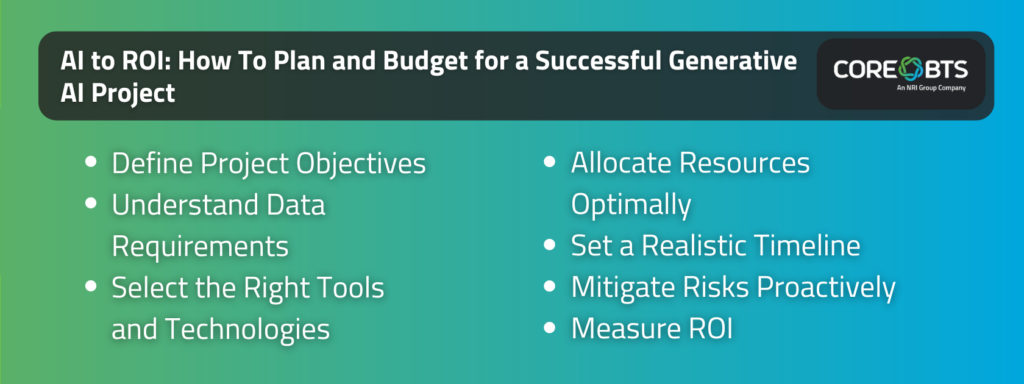Get your AI initiative off the ground in seven steps.

The generative artificial intelligence (AI) market is quickly gaining traction. A recent Fortune Business Insight report projects it will expand from $43.87 billion in 2023 to $67.18 billion in 2024 and hit $967.65 billion by 2032, with a CAGR of 39.6% during the forecast period.
As it stands, 82% of companies are exploring or deploying AI, and over half have accelerated their rollout or AI investments in the last few years. These forward-thinking companies are leveraging generative AI for new ways to innovate, solve problems, and streamline operations.
So, you’re right to consider launching a generative AI project. However, preparation is critical. You must plan and budget carefully for success. You must consider how you’ll navigate ethical concerns, data complexity, AI skills and expertise gaps, and other challenges often in the way of successful generative AI implementation.
This article will help you navigate the complexities of planning and budgeting. You’ll learn everything you need to drive tangible business value with generative AI, including defining objectives and measuring return on investment (ROI). Let’s dive in!
1. Define Project Objectives
Determining objectives is the best place to start when planning and budgeting for your generative AI initiative. In other words, what are you trying to achieve with generative AI, and how does it fit into your organization’s broader strategy?
Your objectives should be specific, measurable, achievable, relevant, and time-bound (SMART). For example, instead of aiming to “improve efficiency,” set a more precise goal like “reducing processing time for customer inquiries by a certain percentage within six months using AI-driven automation.” Doing so will provide clear benchmarks for success and make it easier to measure progress and pivot strategies when necessary.
Also, now is the perfect time to identify the best use cases. Remember, as powerful as generative AI is, other technologies in your toolkit may be better suited to solve pain paints. So, keeping this top of mind from the start is essential to avoid needless spending.
Ideally, you should implement generative AI where the expected value or impact exceeds the implementation effort and cost. Use it for problems you cannot easily solve without AI.
With objectives clear, it’s time to explore requirements.
Watch our on-demand webinar for more information about the state of AI in 2024.
2. Understand Data Requirements
Data is the foundation of any generative AI project. As the saying goes, it’s “garbage in, garbage out” when using generative AI. Even the most sophisticated models require the correct data to produce meaningful results.
You’ll need to understand the initiative’s data requirements and create a solid plan for capturing and managing data.
Start by evaluating your existing data’s quantity, quality, and relevance, then work towards identifying potential data gaps. If you need to include data points, consider how to collect additional data or leverage external sources.
After that, clean and prepare data by removing duplicates, filling gaps, and standardizing formats. This step is paramount since poorly prepared data creates biased outputs.
Now is also the time to consider data security, privacy, and governance, including what it will take to protect data from unauthorized access and potential breaches and which measures to implement to comply with applicable regulations.
Understanding and addressing these requirements will ensure high-quality, reliable inputs and keep data safe from bad actors after deployment.
3. Select the Right Tools and Technologies
The tools and technologies you use directly impact generative AI implementation outcomes.
First, determine your hardware needs and the frameworks and programs you’ll use for development based on the project’s complexity.
Next, decide whether to use a cloud or on-premises infrastructure or balance flexibility with control through a hybrid infrastructure. Also, consider which visualization, deployment, and MLOps tools and platforms you’ll use to manage the AI lifecycle.
By choosing the right tools and technologies, you’ll have taken a significant step toward increasing your AI initiative’s chances of success.
4. Allocate Resources Optimally
The next step is managing resource constraints. Successful generative AI implementation heavily relies on input from DevOps engineers, MLOps engineers, and project managers. Before hiring new talent or leveraging existing resources, consider whether enlisting the services of an AI transformation partner is smarter.
Accurately estimate the costs of hardware, software, data acquisition, personnel, and other expenses. Detail your budget and allocate resources effectively throughout the project lifecycle. Remember to include a fund for unforeseen contingencies that may arise.
When allocating human and financial resources, be sure to account for the project’s complexity, deadlines, and priorities. This careful planning will help prevent delays, cost overruns, and other issues, keeping the project on track with its scope, timeline, and budget.
5. Set a Realistic Timeline
Setting a realistic timeline is a great way to manage expectations. We recommend starting small when implementing AI. For example, you can break the project into manageable phases, such as data preparation, model development, and deployment, and then estimate timeframes for each phase depending on data availability, model complexity, and other resource constraints.
6. Mitigate Risks Proactively
The best way to manage risk is by being proactive.
We recommend conducting a thorough risk assessment to predict and mitigate potential challenges before they become problematic, such as data quality issues, technical difficulties, or compliance challenges.
Diversifying data sources, validating models, and continuously monitoring risks are great examples of ensuring minimally disruptive change from the AI implementation.
7. Measure ROI
Finally, decide which key performance indicators (KPIs) you’ll use to measure the project’s success. These must align with strategic business objectives, such as saving costs, unlocking efficiency, or growing revenue.
Set up mechanisms throughout the project to collect, track, and analyze data for each KPI. Once you have all the relevant information, compare the cost and effort of AI implementation against the value or impact realized. This will provide a clear picture of the ROI. Remember to report these metrics to stakeholders regularly for transparency and accountability.
Let Core BTS Help You Plan and Budget For Your AI Initiative
Proper planning and budgeting often differentiate successful generative AI projects from failed ones. You stand to realize better outcomes by clearly defining objectives, understanding data needs, selecting the right tools, allocating resources wisely, developing realistic timelines, mitigating risks, and measuring ROI. All this can be complex. But the good news is you can simplify AI implementation with Core BTS.
Read our eBook to learn more about unlocking the power and promise of generative AI.
Or, if you’re ready to start your AI transformation, contact us now. We’ll conduct an AI readiness assessment to determine the maturity levels of your technology ecosystem. From there, we’ll help you decide the best AI use cases for your organizations and develop a well-designed solution. And once that’s done, we’ll execute perfect implementation and empower you to manage everything post-deployment.
Get your custom AI assessment.





Share on